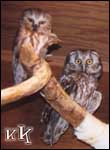 |
 |
 |
Adult |
Juvenile |
Juvenile
moulting into adult plumage |
Boreal Owls are small birds which inhabit the boreal forests of Canada and other circumpolar areas. They are closely related to Northern Saw-whet Owls (Aegolius acadicus) for which they are often misidentified. Boreal Owls, unlike their cousins, have bone to yellow coloured beaks. They are larger and have speckles, rather than streaks, on their foreheads (see below). Juveniles, markedly striking for their bold white V-shaped eyebrows, look much different than their adult counterparts. As autumn approaches though, the dark facial discs and buff undersides are moulted for adult-coloured feathers.
 |
A
Saw-whet on the left, a Boreal on the right. |
Boreal Owls are a rare site at The Owl Foundation. Their northern latitude and small size make them elusive in the wild and thus infrequently found when wounded or ill. Northern Saw-whets often arrive at TOF during migration season when individuals flying south for overwintering are hit by vehicles or collide with buildings (glass is reflective!). Boreal Owls, on the other hand, are non-migratory and live in highly unpopulated areas (luckily this means fewer vehicles too!). However, during particularly harsh winters when food is scarce, Boreals will sometimes fly south in search of prey. Inevitably some of these individuals (especially the weaker, thinner ones) are hit by vehicles. On occasion we also receive young owlet Boreals. Usually these are the unfortunate victims of logging operations. Babes, having toppled from what remains of their nest trees on flatbed trucks, are found at roadsides emaciated with bumps, bruises, fractures, or head trauma.
Unfortunately, Boreals now face a new threat: West Nile Virus. In 2002, The Owl Foundation lost all but two of its Boreal Owls to this disease. The lucky two that survived happened to be sheltered indoors when the plague struck.
Vocalizations:
The typical call heard
is a series of toots quickening in frequency and lowering in pitch near
the end. At TOF, this is usually used as a contact call between individuals
who will vocalize in response to one another. It is also used to attract
a mate.
Vocalizations |
||
|
|
||
| Series
of toots made by a male. |
||
Contact
Call |
||
|
|
||
Contact
Us | Hours | Home
| Legal
© 2008 The Owl Foundation
Owl vocalizations recorded by Kara Kristjanson.
Unless otherwise stated, all photographs and sound files are the property of The Owl Foundation.
No images or sounds on this website are to be duplicated in any way without express written permission
from the party to which they belong.
If you are interested in receiving quality versions, please contact The Owl Foundation.